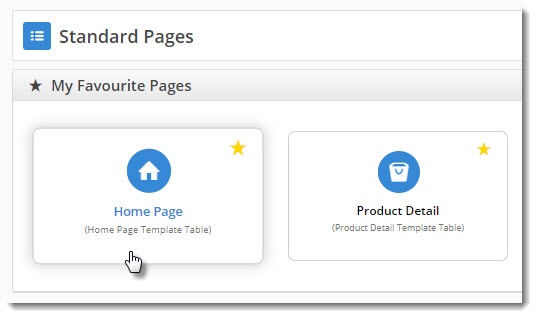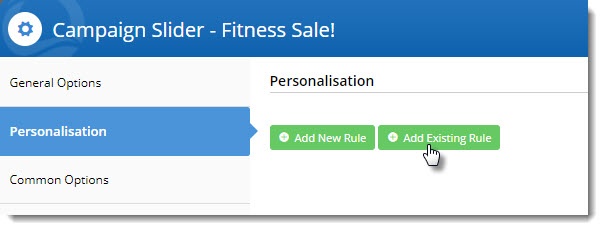Everyone loves it when something is customised just for them. Now, you can tailor the content on your website to the individuals who use it. With your users' preferences in mind, you can display promotions, targeted messaging, and product suggestions. Offering relevant content through personalisation builds loyalty, strengthens customer relationships, and can drive sales. This guide will walk you through Personalisation in the Commerce Vision CMS.
In this guide
Prerequisites
Your website must be running version 4.01.00+ and have the Personalisation feature enabled. Contact our Customer Success Team if you require assistance with this.
Rule Maintenance
Navigate to Advanced Content → Personalisation. Here's the Rule Maintenance page where all of your personalisation rules will live.
You can see existing rules (if you have any), or create a new rule from this screen.
Create New Rule
Let's say we're running a promotion on fitness equipment, and we want to target users who have these products in their Favourites / Wishlist.
- On the Personalisation - Rule Maintenance page, click 'Create New Rule'.
- Enter a name for your rule. Be descriptive - the name might help you easily locate your rule among a long list one day!
- Select a user scenario from the list. You can enter a search term to filter results by keyword.
- Double-click the scenario (or highlight it and click 'Add') to add it to the rule builder.
- Next, set the value of each variable in the scenario:
- some variables will toggle between 2 options on click (has/has not, more/less, etc.)
- other variables will launch a popup on click, where you can define the value (such as a product code, number of days, dollar amount, etc.)
- Repeat steps 3 - 5 if your rule will be built from multiple scenarios.
- Save or Save and Exit.
You can see an example in the video below:
Apply a Rule to a Widget
Now that our rule is created, let's personalise a widget with it. A campaign slider full of fitness products sounds good.
- Navigate to the template the widget is on (in this example, it's the home page).
- Edit the widget you want to personalise (in our case, a campaign slider).
- Select the Personalisation tab, then click 'Add Existing Rule'.
(If you hadn't created the rule already, you could click 'Add New Rule' and follow the above steps for creating a new rule).- Your alphabetical list of rules will open. Locate the one you need and click 'Add'.
- The rule will be added to the widget, but will not be active. You can use the toggle to turn the rule on.
- If you need to edit or delete the rule, hover over the Options menu (we'll cover the Schedule option later in this article).
- Click Save to exit the widget. You'll see it now has a tile indicating that the widget has been personalised!
Take a look here:
Edit a Rule
You can edit a rule at any time, but be aware that any widgets with the rule applied will be affected.
- Navigate to the Rule Maintenance page via Advanced Content → Personalisation.
- You'll see all of your existing rules listed, as well as the number of times each has been applied to a widget.
- Note that rules applied to widgets but not toggled on are not counted here.
- Click Edit on the required widget.
- Update the values in the scenario, or add and remove scenarios as needed.
- If the rule is already in use, you'll see a list of Applied Locatons below the rule builder.
- Clicking on the template name will take you to the template, with the personalised widget highlighted.
Schedule a Rule
You may have a widget you'd like to display to your target audience for a limited time only. This is where Scheduling comes in handy.
- With the widget open for editing, select the Personalisation tab. (If the rule you want is not already there, add it to the widget.)
- Hover on the rule's Options button and select Schedule.
- Click the Calendar icon to select a Start Date. Do the same to select the End Date.
- Click Confirm.
- A clock icon will appear on the rule to indicate that it's running on a schedule (rather than indefinitely).
Personalisation of this widget will now be in effect between the scheduled (local) times. As long at the rule is active (toggled on), the widget content will not be displayed to eligible users until the scheduled start date & time.
Active vs Inactive rules
If you've applied a rule to a widget, but not enabled it (i.e. not toggled it on), the rule will be considered inactive. Widgets with inactive rules will simply behave as normal, which means they will display as though no personalisation has been applied.
Related articles














